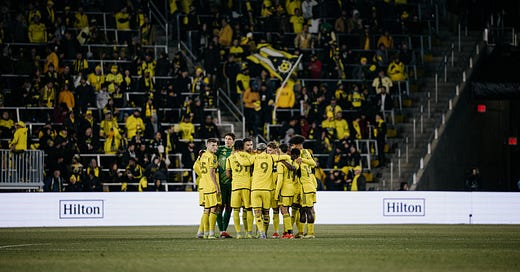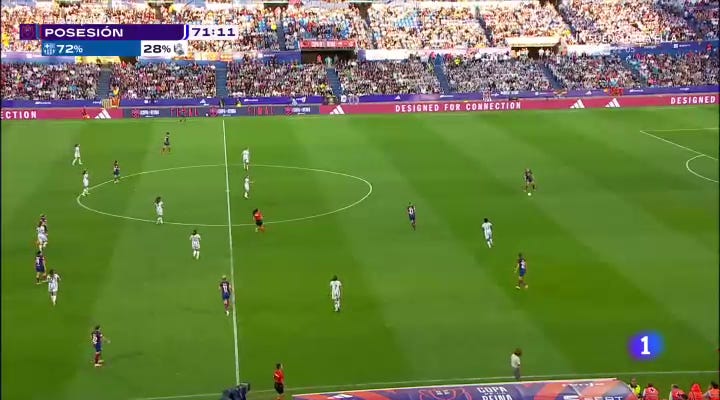Creation & Occupation of Space In Hybrid Systems
A look at where teams create space and when they occupy those spaces
Recently, the Notiziario del Settore Tecnico published a piece called A New Era in which the tactics some of the most innovative teams in Europe this season — Bayer Leverkusen, Inter Milan, and Bologna — were discussed in detail.
While each team had their differences, one thing they had in common was combining positional and relational play.
This post will look at three teams: Bayer Leverkusen, Columbus Crew, and Barcelona Women. We’ll take a look at where these teams created space using a combination of positional and relational play, and how they occupied that space (or did not).
Bayer Leverkusen: Creation Of Space Between the Opposition’s Back and Midfield Line
Bayer Leverkusen setup in a 3-6-1 formation with a back 3, box midfield, 2 wingbacks, and a high positioned center forward.
Their positional players were those that made up the backline, the 2 wingbacks to provide width, and the the center forward. We will be focusing on Leverkusen’s use of the center forward and how he was used to create space for the relational players.
Below is how Xabi Alonso setup his team in the first leg of the Europa League quarterfinal against West Ham.
The space that Leverkusen looked to create throughout the season was between lines so that the two attacking midfielders could receive in this space, or have the freedom to move in this space without interference from the opposition’s backline.
Examples of this were seen in their match against West Ham.
In the image below, Schick (Leverkusen’s center forward highlighted in yellow) was positioned high on West Ham’s backline. This allowed Adli (attacking midfielder highlighted in red and movement shown by red arrow) to move freely between lines.
A similar situation was seen later in the second half.
The proximity of Adli’s positioning to Schick emphasizes Schick’s positional role to pin the backline and create space for the relational players.
Earlier in the season against Bundesliga opponents Heidenheim, Alonso deployed two center forwards, Schick and Adli, with a single attacking midfielder underneath in Wirtz.
In his postgame interview, Alonso discussed that this was done because in their scouting of Heidenheim, they found that their center backs would aggressively step into the midfield to try and disrupt play or regain possession.
That is a valuable area for Leverkusen, so playing with two center forwards ensured that they would still be able to find players in this area. This can be seen in the image below.
Schick and Adli are highlighted in yellow pinning the backline. As a result, Wirtz was able to receive between lines.
Wirtz, one of the relational players in Leverkusen’s setup, greatly benefitted from this space creation from the positional players.
According to Statsbomb, the Bundesliga player of the year received the most line breaking passes in at least 2m of space in the attacking third than any other player in Europe’s top leagues.
Columbus Crew: Occupation Of High Central Areas
The Columbus Crew play a unique and well executed brand of football under Wilfred Nancy.
The Crew play in a 3-4-3, but tend to look different when they are in their attacking half. Nancy’s system has positional and relational positions, but the roles are quite fluid.
The positional roles in Nancy’s system consist of a back 3, a deep lying midfielder, and wide players to stretch the field. The relational roles in his system will often create triangles with the wide players and look to manipulate the opposition in central areas.
It is notable that when they have possession in wide areas, oftentimes they will leave high and central areas vacant.
A look at their formation in these moments can be seen below. This was their lineup against Monterrey in the second leg of the Concacaf Champions League.
As mentioned previously, the highlighted space in blue shows the high central areas that the Crew will not occupy, at least not for long periods of time.
Earlier in the MLS season against Minnesota United, the Crew had the ball out wide on the right side, as seen below.
There was nobody high and central, the Crew did not look to be dangerous in this particular moment.
However, 3 seconds later as the ball was being struck for a cross by the right wing back, the Crew had occupied the box with players in dangerous positions.
Cucho, highlighted in red, got a head on the cross and forced a save from the Minnesota goalkeeper.
A similar situation was seen when the Crew visited Monterrey for the second leg of the Champions league.
Again, the Crew had the ball out wide on the right side, and again there was nobody occupying high central areas.
When the Crew managed to switch the field, there was still not much of a high central presence in dangerous areas.
When it was time to finish the attack, Diego Rossi (highlighted in red) made a well timed run and other Crew players were also occupying dangerous areas.
In their fluid system of positional and relational roles, the Crew are good at hiding their intentions.
Barcelona Women: Creation Of Space In The Midfield
In their recent win over Real Sociedad in the Copa de La Reina, Barcelona used positional players on the perimeter of the field in order to create space for the relational players in the center of the field.
The image below shows Barcelona’s lineup in the second half, and the space they looked to create.
From their starting positions, the relational players (Alexia, Mariona, and Pina) looked like positional players. This was to create space in the areas that they later wanted to occupy and manipulate.
This can be seen in the first example below.
Alexia checked down into the midfield space they had created, and Mariona made a countermovement into the space behind.
Later in the half, Barcelona were in a similar setup.
As the ball came to the right side, Pina checked down into the space, similar to what Alexia had done earlier.
However, there was opportunity for Pina to make the run in behind, which she did. Rolfo made the countermovement down.
Conclusion
As stated in A New Era, space is one of the most important variables within football. It is fascinating to watch how top level teams define what space is valuable to them and how they decide to occupy it.
Photo: @ColumbusCrew Twitter


















